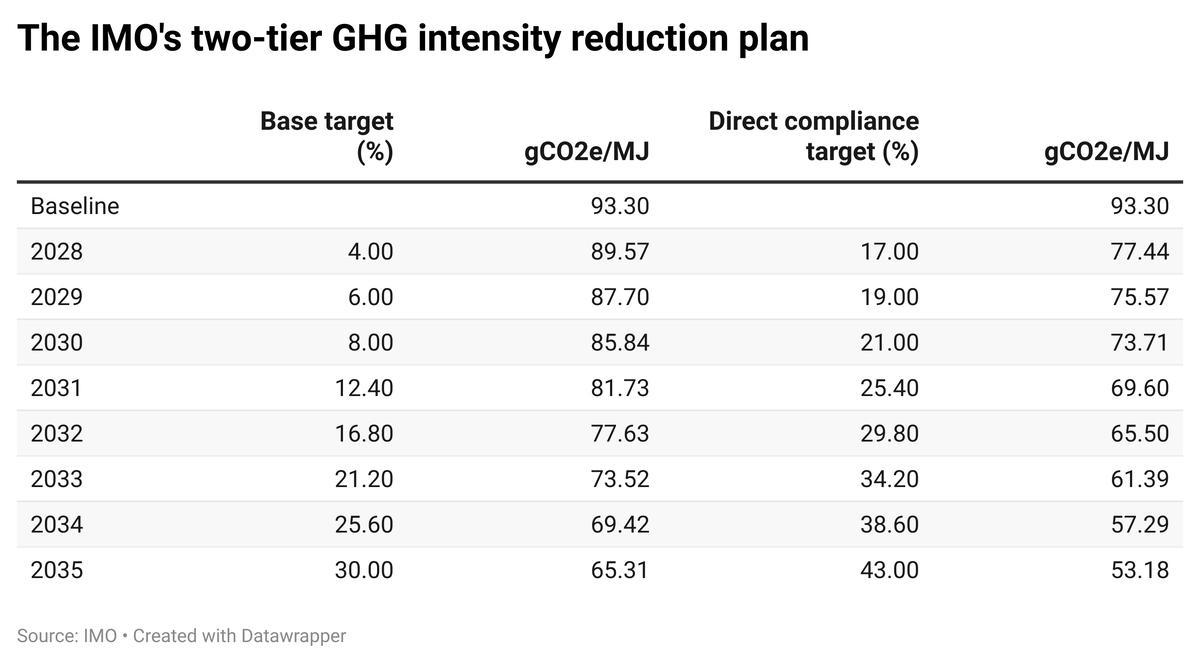LBM and B100 poised for high returns under IMO framework
VLSFO could face penalties of $80/mt in 2028 and $450/mt in 2035
B100 and LBM stand to earn surplus credits
 TABLE: Annual GHG fuel intensity reduction targets for base and direct compliance, relative to the GFI reference value. IMO, ENGINE
TABLE: Annual GHG fuel intensity reduction targets for base and direct compliance, relative to the GFI reference value. IMO, ENGINE
We have used the GHG fuel intensity values provided by the EU under the FuelEU Maritime regulation for our calculations, as the IMO’s lifecycle assessment (LCA) guidelines do not currently offer clear figures for the well-to-wake GHG intensities of all fuels.
The Global Centre for Maritime Decarbonisation (GCMD) has developed a new calculator to estimate the future cost of emissions under the IMO’s approved mid-term measures.
ENGINE’s calculations using this tool show that fossil fuels like VLSFO and high-methane-slip LNG setups will carry increasing compliance costs, while low-emission alternatives such as B100 (100% biofuel) and liquefied biomethane (LBM) may offer substantial financial upside in the early years of the regulation.
Liquid fuels
According to the IMO’s draft framework, if a vessel’s GHG intensity is lower than the "base target", but higher than the "direct compliance target", the shortfall must be compensated by purchasing "remedial units" at $100/mtCO2e.
If a vessel’s GHG intensity fails to meet even the base target, it will incur two separate charges: $100/mtCO2e to cover the shortfall towards the direct compliance target and an additional $380/mtCO2e for its shortfall towards the base target.
VLSFO, with a GHG fuel intensity of 91.60 gCO2e/MJ, falls short of both the base (89.57 gCO2e/MJ) and the direct compliance (77.44 gCO2e/MJ) targets in 2028. As a result, a vessel running on VLSFO could face a net penalty of around $80/mt in 2028.
The penalty is only expected to increase in the following years.
The projected penalty for using VLSFO could reach approximately $450/mt in 2035, when the base (65.31 gCOe2/MJ) and direct (53.18 gCOe2/MJ) compliance targets tighten even further.
In contrast, using 100% FAME-based biofuel (B100) stands to generate strong positive returns.
Since B100 (16.23 gCO2e/MJ) is well below both compliance targets, it could earn a potential surplus of around $860/mt in 2028. While the value of this surplus is expected to decline as targets become more stringent, B100 is still estimated to earn around $520/mt in 2035.
Liquid gases
LNG’s position is more complex and highly dependent on engine type and its methane slip levels.
ENGINE analysis earlier showed that an LNG dual-fuel vessel using Otto medium-speed (Otto MS) engine (91.03 gCO2e/MJ) with the highest methane slip at 3.1% could be non-compliant with both thresholds from day one.
This vessel could face a penalty of roughly $90/mt in 2028, progressively rising to around $540/mt by 2035.
But if the same Otto MS engine is fuelled with 100% liquid biomethane (LBM100, 30.22 gCO2e/MJ), the outcome shifts dramatically. This vessel can earn significant surplus credits even under the tightening framework, with potential earnings ranging from around $900/mt in 2028 to $440/mt by 2035.
On the other side of the spectrum, fossil LNG vessels using diesel slow-speed (diesel SS) engines perform better in the short term, thanks to significantly lower methane slip around 0.2% and a GHG intensity of 76.13 gCO2e/MJ.
These ships are expected to meet both base and direct targets in 2028, earning a modest surplus of about $24/mt.
But that advantage fades quickly.
Diesel SS engines will not meet the direct target after 2029, and even fall short of the base target by 2033. This compliance shift translates from earning a surplus to incurring penalties, starting at $3/mt in 2029 - rising to a $110/mt penalty by 2033 - and climbing to $260/mt in 2035.
Switching from fossil LNG to LBM100 dramatically improves the compliance outlook.
A diesel SS-powered dual-fuel vessel using LBM100 (15.59 gCO2e/MJ) could earn a surplus of $1,175/mt in 2028. Even by 2035, when compliance thresholds are at their tightest, the vessel would still be earning a surplus, around $710/mt in value.
This analysis shows that fuel type and engine configuration will play a decisive role in determining whether a vessel pays penalties or earns surplus credits under the newly approved regulatory regime. While the long-term climate impact is still unclear, the IMO framework penalises fossil fuels based on their GHG intensity, and rewards low-emission fuels.
The framework will now be up for formal adoption in October 2025, with entry into force expected 16 months after adoption.
By Konica Bhatt
Please get in touch with comments or additional info to news@engine.online






